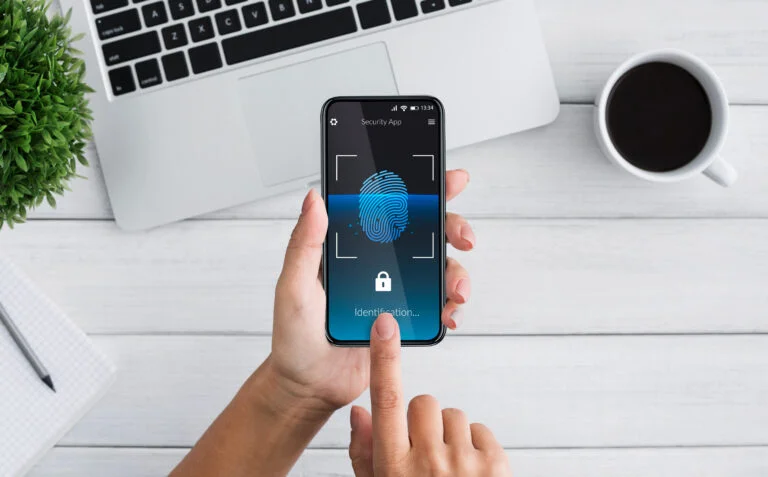Menu

biometrics /ˌbʌɪə(ʊ)ˈmɛtrɪks/ noun
A biometric token is like a special key that uses something unique about your body to unlock things, like your phone or bank account.
Instead of a regular key or a password, it might use your fingerprint, your face, your dna or something else that’s unique to you.
So, when you use your fingerprint to unlock your phone, that’s a biometric token in action – your “magical key” confirming it’s really you.
Recently advances in AI and cryptographic techniques have paved the way for more secure handling of biometric information through the use of biometric tokens.
Biometric Tokenization : When a user registers their biometric data (e.g., fingerprint, face scan) with a system, AI can create a unique biometric token based on that data. This token is essentially a mathematical representation of the biometric information.
Secure Encryption : AI utilizes strong encryption algorithms to transform the biometric token into a cryptographic token. This cryptographic token is a randomized string of characters that can’t be reversed or linked back to the original biometric data without the encryption key.
Decentralized Storage : Instead of storing the raw biometric data centrally on a server, the cryptographic tokens can be distributed across a decentralized network or stored locally on the user’s device. This decentralization minimizes the risk of a single breach compromising all biometric data.
Authentication Process : When a user wants to authenticate themselves, AI compares their current biometric data (e.g., a fingerprint scan) with the stored cryptographic token on their device. This comparison is done locally and doesn’t involve sending the biometric data over the network.
Privacy Protection : Since the actual biometric data is never transmitted or stored centrally, users have greater control over their biometric information. This protects their privacy and reduces the risk of identity theft in case of a breach.
Two-Factor Authentication (2FA) : AI can combine the use of biometric tokens with other authentication factors, such as a PIN or a password, to create a robust 2FA system. This adds an extra layer of security.
Revocable Tokens : In case of compromised or compromised biometric data, the cryptographic tokens can be revoked or reissued without needing to change the user’s biometric information, further enhancing security.
Machine Learning for Continuous Monitoring : AI can continuously monitor the usage of biometric tokens, looking for anomalies or suspicious activities. This helps in detecting and preventing fraudulent access attempts.
It ensures that even if a breach occurs, attackers cannot access the original biometric data, providing a higher level of protection for users’ sensitive information.
Here are some ways in which biometric tokens are used in banking:
Biometric Payments : Biometric tokens can be used for in-store payments. Customers link their biometric data to their bank accounts, and then they can make payments by scanning their fingerprint or using facial recognition at compatible point-of-sale terminals.
Account Recovery : Biometric authentication can be used to securely recover a locked or forgotten account. Customers can verify their identity through biometrics instead of going through lengthy identity verification processes.
Biometric Authentication: Banks are implementing biometric authentication methods like fingerprint recognition, facial recognition, or iris scanning to allow customers to access their accounts securely. Instead of traditional passwords, customers can use their biometric data to log in.
Mobile Banking Apps: Many banking apps on smartphones now support biometric authentication. Users can access their accounts or authorize transactions using fingerprint or facial recognition, making mobile banking more convenient and secure.
ATM Access: Some banks have integrated biometric authentication into their ATMs. Customers can use their fingerprints or palm prints to withdraw cash or perform other transactions, reducing the risk of card skimming or PIN theft.
Voice Biometrics : Voice recognition technology is used for verifying a customer’s identity over the phone. The unique characteristics of a person’s voice can be used as a biometric token for customer service interactions.
Digital KYC : Biometric tokens are used in the Know Your Customer (KYC) process. Customers can verify their identity during the account opening process by providing biometric data, enhancing the accuracy and security of KYC procedures.
Fraud Detection : Biometric tokens can be used to detect fraudulent activities. AI algorithms can continuously monitor biometric data to detect unusual patterns or multiple authentication attempts, signaling potential fraud.
Multi-Factor Authentication (MFA) : Biometric tokens can be integrated into multi-factor authentication systems, where they serve as one of the authentication factors alongside something the user knows (e.g., a PIN) and something the user has (e.g., a smartphone).
Enhanced Security : Biometric tokens offer a high level of security because they are unique to each individual, difficult to forge, and not easily shared or stolen.
So overall, biometric tokens in banking offer a more secure and convenient way for customers to access their accounts, make transactions, and protect their financial information.
They play a crucial role in combating fraud and improving the overall banking experience.
SECURELY HOLDINGS PTY LTD is registered as an independent remittance provider Registration Number IND100809706-001. Copyright 2023 Securely-App All Rights Reserved.
Acknowledgement of Country
The management and staff of Securely Holdings recognises the Kabi Kabi (Gubbi Gubbi), the First Peoples of the land on which we work and reside and their ongoing connection to culture and country. We acknowledge First Nations Peoples as the Traditional Owners, Custodians and Lore Keepers of the world’s oldest living culture and pay respects to their Elders past, present and emerging.